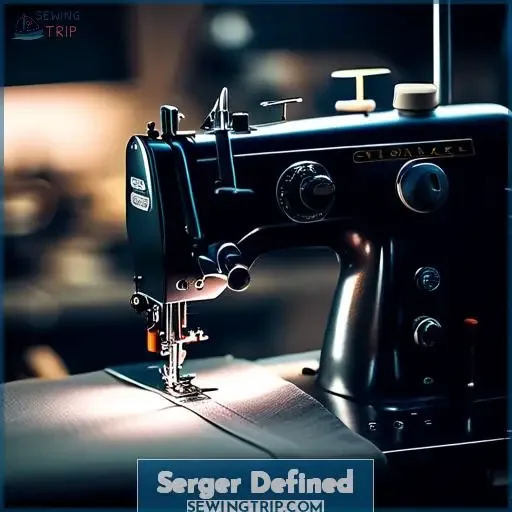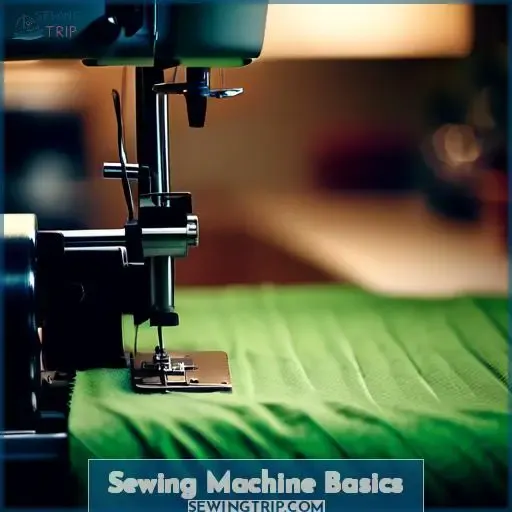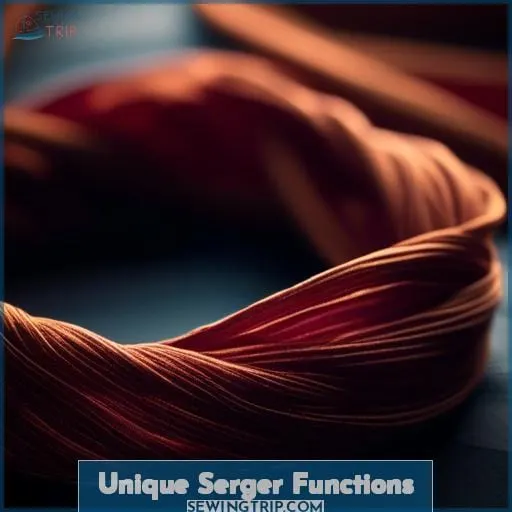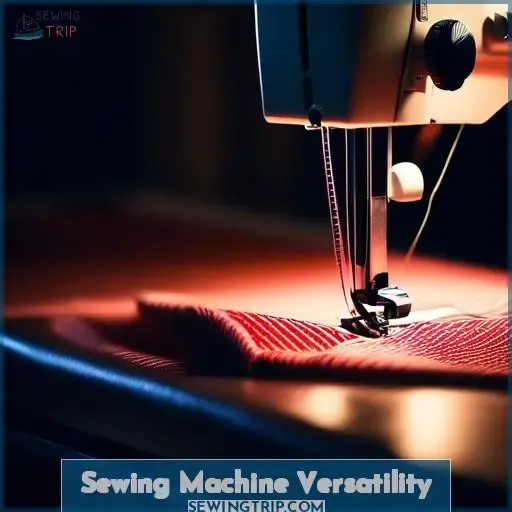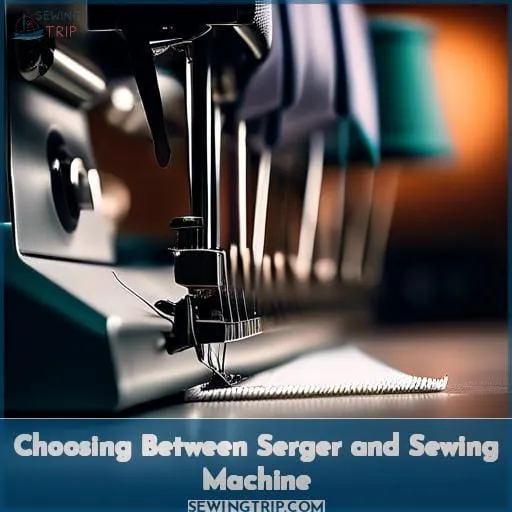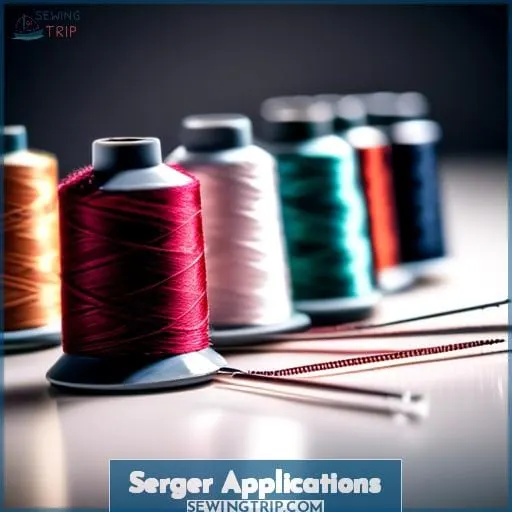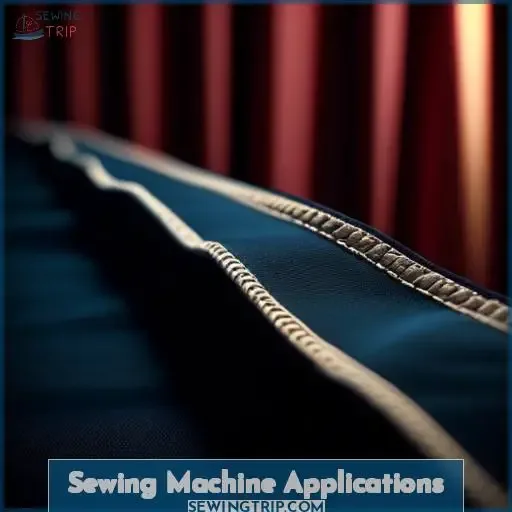This site is supported by our readers. We may earn a commission, at no cost to you, if you purchase through links.
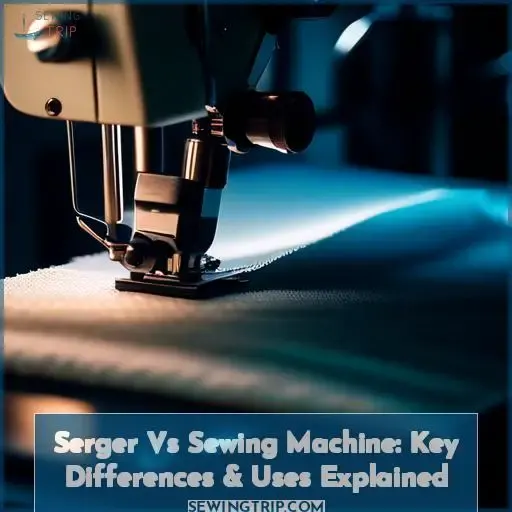 Imagine standing at the crossroads of creativity and efficiency, where the paths of sergers and sewing machines diverge. You’re equipped with a map that guides you through the terrain of fabric and thread, but each machine opens up a different route.
Imagine standing at the crossroads of creativity and efficiency, where the paths of sergers and sewing machines diverge. You’re equipped with a map that guides you through the terrain of fabric and thread, but each machine opens up a different route.
A serger, with its overlock stitch mastery and multi-thread capability, is like a high-speed train, slicing and dicing fabric edges while encasing them in neat, stretch-resistant seams. It’s the expressway to finishing garments and working with stretchy fabrics, where speed and durability are paramount.
On the other hand, the sewing machine, with its lockstitch and chain stitch versatility, is akin to a versatile vehicle, capable of intricate topstitching, decorative stitches, and handling delicate fabrics with precision.
As you ponder your project requirements and desired stitch quality, this guide will illuminate the unique functions and applications of each machine, helping you choose the right tool for your creative journey.
Yes, a serger can perform tasks that a sewing machine cannot, such as trimming fabric allowance while simultaneously stitching and overcasting the edges of the fabric for a professional finish.
Table Of Contents
Key Takeaways
- Sergers trim the fabric edge while sewing, which sewing machines cannot do without additional cutting steps.
- Sergers use 3-4 thread sources to create durable overlock stitches, unlike sewing machines that typically use one or two.
- Sergers can sew at high speeds (up to 1300 stitches per minute), faster than most sewing machines.
- Sergers are ideal for finishing seams and edges on stretchy fabrics and high-wear areas, providing a professional finish that sewing machines cannot achieve with their standard stitches.
Serger Defined
A serger, distinct from a sewing machine, excels in edge finishing and handling stretch fabrics.
You’ll appreciate its ability to create overlock stitches, which are inherently stretchy and ideal for knit garments, something a sewing machine can’t replicate with the same proficiency.
With its multi-thread capability, a serger can simultaneously trim, stitch, and finish edges, streamlining the sewing process for a professional appearance.
Overlock Stitch Mastery
A serger’s claim to fame is crafting the overlock stitch – that professional finish you see on ready-to-wear.
Forming the stitch means expertly balancing four interconnected components: stitch quality, thread tension, fabric choice, and needle selection.
Mess up the harmony, and you’ll be troubleshooting skipped stitches all day.
But master the overlock, and you can transform knits, tackle trims confidently, and get garments looking factory-made, all with the help of loopers and that built-in knife.
Multi-Thread Capability
Unlike single or dual thread sewing machines, sergers utilize three or more thread sources for professional finishing.
Their specialized tension system expertly balances multiple threads, allowing variation in thread colors and thicknesses.
With multiple high-quality threads interlocking, sergers create durable seams able to withstand stretching and wear.
This multi-thread mastery achieves the clean finish found on ready-to-wear garments.
Sewing Machine Basics
Understanding the basics of sewing machines, including the differences between lockstitch and chain stitch, is essential for anyone interested in fabric and garment construction.
A sewing machine primarily uses a lockstitch, which involves a needle thread from the top and a bobbin thread from below to create a secure stitch that’s ideal for a wide range of fabrics.
On the other hand, a chain stitch, which isn’t typically found on standard sewing machines, uses one or more thread sources to create loops that interlock, offering a stretchable seam perfect for knit fabrics.
This distinction is crucial for selecting the right machine and stitch type for your project, ensuring durability and the desired finish.
Lockstitch and Chain Stitch
A serger, also known as an overlock machine, is a specialized sewing machine that creates an overlock stitch using multiple threads, typically three or four. It’s designed to bind fabric edges, providing a professional finish similar to what you’d find in store-bought garments.
Sergers are capable of cutting the fabric as they sew, which allows for faster operation compared to a traditional sewing machine. They’re particularly useful for projects that require a durable stitch, such as those with high wear, and can give a professional look to the finished garment.
On the other hand, a sewing machine typically uses a lockstitch or chain stitch and operates with one or two thread sources. Unlike sergers, sewing machines don’t have a built-in blade to cut the material and can sew in multiple directions, which allows for a greater variety of stitches, including topstitching and decorative stitches.
Sewing machines are versatile and can handle a wide range of fabrics and sewing techniques.
When deciding between a serger and a sewing machine, consider the following:
- Use a serger when you need to quickly finish edges, work with stretchy fabrics, or require a strong, durable stitch for high-wear areas.
- Opt for a sewing machine when topstitching is necessary, when you need a variety of stitch options, or when working with delicate fabrics where cutting isn’t desired.
Both sergers and sewing machines have their unique advantages and are often used together in sewing projects to achieve the best results. For instance, a serger can be used to finish seams and edges, while a sewing machine can be used for constructing the garment and adding detailed stitching.
Single or Dual Thread Use
A serger, also known as an overlock machine, is a specialized sewing machine that creates an overlock stitch to bind fabric edges, providing a professional finish similar to what you’d find in store-bought garments.
It operates with three or more threads to simultaneously trim, stitch, and overcast fabric edges, making it ideal for finishing seams, sewing rolled hems, and working with stretchy fabrics. Sergers are known for their speed and ability to create durable stitches, particularly suited for high-wear projects.
On the other hand, a traditional sewing machine typically uses a lockstitch or chain stitch and is equipped with one or two thread sources. It doesn’t have the capability to cut fabric while sewing and can sew in multiple directions, offering a wide variety of stitch options including topstitching and decorative stitches.
Sewing machines are versatile and can handle a range of fabrics and sewing techniques, making them essential for completing most sewing projects.
When deciding between a serger and a sewing machine, consider the following:
- Use a serger for projects that require a professional finish, durability, and speed, especially when working with stretchy fabrics or finishing edges.
- Opt for a sewing machine when topstitching is needed, when a variety of stitch options is desired, or when working with delicate fabrics that don’t require the cutting feature of a serger.
Both machines serve different purposes and complement each other in a well-equipped sewing space. For comprehensive sewing projects, it’s beneficial to have access to both a serger for its specialized functions and a sewing machine for its versatility and range of stitching techniques.
Unique Serger Functions
A serger, unlike a sewing machine, has the capability to trim the fabric edge while it binds the pieces together, providing a clean and professional finish.
This machine operates at a high speed, often reaching up to 1300 stitches per minute, which significantly speeds up the sewing process.
Additionally, a serger can handle multiple threads simultaneously, typically using 3 to 4 threads to create strong, stretch-resistant seams, which is something a conventional sewing machine can’t do.
Fabric Cutting Feature
A serger, also known as an overlock machine, is a specialized sewing machine that provides a professional finish to the edges of fabric. It’s particularly adept at handling stretchy materials and can significantly speed up the garment-making process.
Sergers use multiple threads (usually three or four) to create an overlock stitch that not only seams fabric but also trims and finishes the raw edges in one go, preventing fraying.
The serger’s knives are a key feature, allowing it to cut the fabric as it sews, which is essential for maintaining clean and even edges. This capability is especially useful when working with fabrics that have long floats, as it ensures a tidy finish without any loose threads.
The differential feed on a serger also allows for a more controlled feed of stretchy materials, ensuring that the seams lay flat and don’t pucker.
When it comes to space requirements, sergers like the Brother 1034D are compact enough to fit into most sewing spaces, yet they offer a powerful performance that can rival larger machines. The serger’s speed boost is another advantage, with some models capable of reaching speeds of up to 1,300 stitches per minute, making them a goldstar tool in the realm of efficient garment making.
For those looking to expand their sewing toolkit, additional serger accessories can further enhance the machine’s capabilities, allowing for a wider range of stitches and finishes. These accessories can include various presser feet for different types of stitches, such as rolled hems or piping, as well as attachments for beading or blind stitching.
In summary, a serger is an invaluable addition to any sewing room, particularly for those who are serious about garment making. Its ability to create durable, professional-quality overlock stitches, coupled with its fabric cutting feature and adaptability to different materials, makes it a distinct and powerful complement to the traditional sewing machine.
High-Speed Sewing
Definition and Function
Serger: A specialty sewing machine that uses an overlock stitch to create professional-grade binding. It trims, stitches, and overcasts fabric edges simultaneously, creating professionally finished seams.
Sewing Machine: A lockstitch machine that covers basic stitches and may have decorative stitch options. It uses a mechanically driven needle for sewing or stitching cloth and can perform various tasks including basic manual stitching, embroidery, and decorative stitching.
Stitch Type
Serger: Utilizes the overlock stitch, which isn’t typically available on standard sewing machines. This stitch is suitable for different types of finishes and is created with 2, 3, or 4 threads.
Sewing Machine: Primarily uses the lockstitch or chain stitch, which involves a single or dual thread source.
Thread Sources
Serger: Employs three or more thread sources, which contribute to the strength and durability of the stitch.
Sewing Machine: Generally uses one or two thread sources, which is sufficient for most basic sewing tasks.
Functionality
Serger: Capable of cutting material as it sews and sews only along the left side of the needles. It’s designed for specific tasks like overcasting and finishing edges.
Sewing Machine: Can’t cut material and can sew in multiple directions, offering versatility for a wide range of sewing projects.
Applications
- To eliminate tedious work in garments and projects, especially when a professional look and durable stitch are required for high-wear areas.
- Sergers are preferred for their faster sewing speed and for finishing fabric edges, sewing rolled hems, and working with stretchy fabrics.
- For topstitching, which is essential for completing most projects, and when a wide variety of stitch options is needed.
- Sewing machines are better suited for making buttonholes, topstitching, creating decorative stitching, and can sew on different types of fabric.
Sewing Machine Versatility
When considering the versatility of a sewing machine, it’s important to recognize its ability to perform topstitching and decorative stitches, as well as its capability for multi-directional sewing.
Unlike a serger, a sewing machine can create a wide array of decorative stitches, adding aesthetic detail to your projects. Moreover, certain advanced sewing machines allow for sewing in multiple directions, which can be particularly useful for complex sewing tasks and creative applications.
This feature enables you to sew in any direction with almost any stitch, enhancing the functionality and creative potential of your sewing projects.
Topstitching and Decorative Stitches
When comparing sergers and sewing machines, it’s important to understand their distinct capabilities and applications. A serger, also known as an overlock machine, is specialized for binding fabric with an overlock stitch, typically using three or four threads.
It trims the fabric as it sews, which allows for a clean, raw edge and a stronger, more durable stitch. Sergers are faster than sewing machines and are ideal for projects that require a professional finish, such as garment construction, especially when working with stretchy fabrics.
On the other hand, a sewing machine is versatile, capable of creating lockstitch or chain stitch with one or two thread sources. It excels in topstitching, which is essential for completing most projects, and offers a wide variety of stitch options, including decorative stitches.
Sewing machines can handle a range of fabric types and can sew in multiple directions, unlike sergers which sew only along the left side of the needles.
When to use a serger:
- For projects that benefit from a professional look and durable stitch, such as high-wear garments.
- When you want to eliminate tedious work by cutting and sewing fabric simultaneously.
- For faster sewing speeds compared to a sewing machine.
When to use a sewing machine instead:
- For topstitching, which isn’t possible with a serger.
- When a project requires a variety of stitch options, including decorative stitching.
- For sewing on different types of fabric, including delicate fabrics where cutting isn’t necessary.
In summary, sergers and sewing machines serve different purposes in sewing. A serger is best for edging, hemming, and seaming, especially for stretchy fabrics, providing a professional finish quickly. A sewing machine, however, is more versatile, suitable for a broader range of sewing tasks, including topstitching and decorative stitching.
Both machines complement each other and can be used together for comprehensive sewing projects.
Multi-Directional Sewing
A serger, also known as an overlock machine, is a specialized sewing machine that creates an overlock stitch using 3 or 4 threads, which binds fabric edges while simultaneously cutting the fabric. This machine is particularly faster than a traditional sewing machine and is used for tasks that require a clean, durable finish, such as garment construction and working with stretchy fabrics.
Sewing machines, on the other hand, typically use 1 or 2 threads to create lockstitch or chain stitch. They don’t have the capability to cut fabric while sewing and can sew in multiple directions, allowing for a wide variety of stitches including topstitching, decorative stitching, and working with delicate fabrics.
When deciding between a serger and a sewing machine, consider the project at hand. Use a serger for projects that require a professional finish, durability, and speed, such as constructing garments or working with stretchy materials.
A sewing machine is more versatile and suitable for a wider range of stitches and fabrics, including topstitching, which is essential for many sewing projects.
Sergers are characterized by their multiple thread sources, typically ranging from 4 to 8, and may have features like adjustable stitch width and length, differential feed, and a retractable upper knife.
Sewing machines usually have a single thread source and offer a variety of presser feet and stitch options.
In summary, sergers and sewing machines serve different purposes in sewing. Sergers are ideal for edging, hemming, and seaming, especially for stretchy fabrics, while sewing machines offer greater versatility for a wide range of sewing tasks, including decorative and precision work.
Choosing Between Serger and Sewing Machine
When deciding between a serger and a sewing machine, consider your project requirements and desired stitch quality.
Understanding the unique capabilities of each machine will help you achieve professional finishes and efficient sewing results tailored to your specific needs.
Project Requirements
When deciding between a serger and a sewing machine, consider the project requirements. Sergers offer a professional appearance with strong, durable seams, ideal for high-wear items.
Sewing machines provide a wide variety of stitches and topstitching capabilities, essential for many projects.
Choose based on the desired stitch quality, fabric durability, and cost-effectiveness for your specific sewing needs.
Desired Stitch Quality
When deciding between a serger and a sewing machine, consider the desired stitch quality for your project. Sergers are the go-to for durable finishes and professional seams, especially when time efficiency is key.
They handle fabric with finesse, providing strong stitches that are essential for high-wear areas.
Sewing machines, on the other hand, offer a wider range of stitches and are indispensable for topstitching and working with delicate fabrics. Each machine has its unique strengths, so choose based on the specific needs of your sewing endeavor.
Serger Applications
When considering the applications of a serger versus a sewing machine, it’s essential to understand their distinct capabilities, especially in garment construction and handling various fabrics.
A serger, with its ability to create clean, professional edges and seams, excels in finishing fabric edges, working with stretchy materials, and ensuring durable, stretchable seams ideal for knit fabrics.
This machine is particularly adept at handling tasks that require both cutting and sewing simultaneously, offering a speed and efficiency that a traditional sewing machine can’t match.
On the other hand, sewing machines provide a broader range of stitching options, including topstitching and working with a wider variety of fabrics, making them indispensable for detailed and decorative work.
Therefore, choosing between a serger and a sewing machine—or deciding to use both—depends on the specific requirements of your project, including the type of fabric you’re working with and the finish you aim to achieve.
Garment Finishing
When considering the use of a serger versus a sewing machine for garment finishing, it’s important to understand their distinct capabilities. Sergers are particularly adept at providing a professional finish to fabric edges, which is essential for garments that require a clean and durable edge.
- Fabric Tension: Sergers handle fabric tension expertly, ensuring that edges don’t wave or pucker, which is crucial for stretchy materials.
- Needle Selection: The choice of needles in a serger can affect the integrity of the stitch, especially when dealing with different fabric types.
- Thread Selection: Using the correct thread for your serger can significantly impact the quality of edge finishing and seam types.
For garment finishing, a serger’s ability to trim and overcast fabric edges in one step provides a neat and attractive finish, which is much faster than using a regular sewing machine. The differential feed feature of sergers also allows for perfect seams on various fabrics, which isn’t typically available on sewing machines.
Additionally, the use of multiple threads in a serger contributes to the durability and stretchiness of the seams, making it ideal for high-wear projects.
Working With Stretchy Fabrics
When working with stretchy fabrics, your serger is your secret weapon. Thanks to its differential feed, you can prevent the dreaded wavy seams that often plague stretch materials.
Imagine the elasticity and durability of your seams matching the fabric’s stretch without a hitch.
And let’s not forget the magic of rolled hems, which add that neat, professional touch to your projects, making them look like they just waltzed off a high-end runway.
With a serger, you’re not just sewing; you’re crafting garments that stand the test of time and movement.
Sewing Machine Applications
When considering the applications of sewing machines, it’s essential to recognize their unique capabilities, especially in tasks where sergers mightn’t be the best fit.
Sewing machines excel in creating buttonholes and installing zippers, tasks that are crucial for many garment constructions but beyond the scope of a serger’s capabilities.
Additionally, sewing machines are better suited for handling delicate fabrics, offering a gentler approach that prevents damage to these sensitive materials.
This versatility and precision make sewing machines indispensable for a wide range of sewing projects, complementing the speed and efficiency of sergers for a comprehensive sewing toolkit.
Buttonholes and Zippers
When tackling buttonholes and zippers, your trusty sewing machine is the MVP. It’s like a Swiss Army knife for fabric, deftly handling delicate tasks that a serger wouldn’t dare touch.
Imagine effortlessly creating buttonholes with precision or installing zippers that slide smoother than a buttered-up banister. It’s the go-to for adding those essential finishing touches to your masterpiece.
Delicate Fabric Handling
When handling delicate fabrics, you’ll want to tread lightly to avoid any sewing snafus. Start by selecting the right needle—think of it as choosing the perfect dance partner for your fabric.
A fine needle, like a 65/9 or 70/10, will glide through without a snag. Thread tension is another delicate dance; it should be just tight enough to embrace the fabric without puckering.
Stitch length is the rhythm; for lightweight fabrics, a shorter 2.0-2.5mm stitch keeps the seam smooth and even. And for edge finishing, consider a gentle serger touch or a rolled hem to keep things neat without adding bulk.
Frequently Asked Questions (FAQs)
How do you maintain and clean a serger to ensure its longevity and optimal performance?
To keep your serger humming along, start by giving it a spa day: unplug, open up, and gently vacuum the linty guts.
Use a soft brush for the nooks and crannies, then treat it to a few drops of oil on the moving parts.
Reassemble, test with scrap fabric, and listen to it purr.
Can a serger be used for quilting projects, and if so, what specific techniques or adjustments are recommended?
You can indeed quilt with a serger. It is like a shortcut through the fabric jungle. Just remember to use a longer stitch length to reduce bulk. Practice on scraps to get the hang of it.
What are the environmental impacts of using a serger compared to a traditional sewing machine, considering energy consumption and waste production?
Like a tailor with a keen eye for the perfect fit, a serger trims excess fabric, leaving behind seams as neat as a pin and as strong as an ox.
Sergers, unlike traditional sewing machines, can cut and overcast fabric edges in one fell swoop, reducing waste and energy use by streamlining the process.
However, they typically consume more power due to their higher speeds and additional thread sources, potentially leading to greater energy consumption and associated environmental impacts.
How does the learning curve for operating a serger compare to that of a sewing machine for beginners?
You’ll find a serger’s learning curve steeper than a sewing machine’s. It involves mastering multiple threads and complex tension adjustments.
Are there any innovative or unconventional uses for a serger that go beyond its typical applications in garment construction and finishing?
In the realm of sewing, a serger is like a magician’s wand, transforming the mundane into the magnificent. Beyond its traditional role in garment construction and finishing, this versatile tool can weave a tapestry of creativity across a variety of projects.
Imagine crafting delicate rolled hems on napkins that whisper tales of elegance at dinner parties or adding a touch of whimsy to home decor with ruffled edges that dance along the seams of cushions. With a serger, you can also venture into the world of activewear, using its robust stitches to create pieces that stretch and move with the grace of a ballet dancer.
The serger’s ability to handle decorative threads opens a Pandora’s box of possibilities, allowing you to embellish with beads, ribbons, or even create custom piping that adds a signature touch to your creations.
So, as you thread your serger, remember that you’re not just sewing; you’re embarking on a journey of exploration, where the only limit is your imagination.
Conclusion
Embarking on your sewing journey, imagine your fabric as a canvas and your choice between a serger and sewing machine as your brushes.
Each tool paints with unique strokes; the serger swiftly encases edges with its overlock prowess, doing what a sewing machine cannot—trimming and finishing edges in one fell swoop.
As you weave through your project’s needs and stitch desires, remember this distinction. Let your creative vision guide you, choosing the tool that best brings your textile masterpiece to life.

